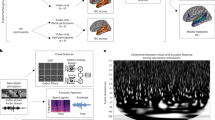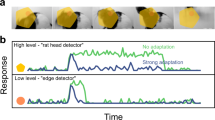Abstract
It has been proposed that the human visual system can use temporal synchrony to bind image regions into unified objects1,2,3, as proposed in some neural models4. Here we present experimental results from a new dynamic stimulus suggesting that previous evidence for this hypothesis can be explained with the well-established mechanisms of early visual processing, thus obviating the need to posit new synchrony-sensitive grouping mechanisms (see also ref. 5 for a critique of the binding by neural synchrony hypothesis).
This is a preview of subscription content, access via your institution
Access options
Subscribe to this journal
Receive 12 print issues and online access
$209.00 per year
only $17.42 per issue
Buy this article
- Purchase on Springer Link
- Instant access to full article PDF
Prices may be subject to local taxes which are calculated during checkout



Similar content being viewed by others
References
Fahle, M. Proc. R. Soc. Lond. B Biol. Sci. 254, 199–203 (1993).
Usher, M. & Donnelly, N. Nature 394, 179–181 (1998).
Lee, S. & Blake, R. Science 8, 1165–1168 (1999).
Singer, W. & Gray, C. Annu. Rev. Neurosci. 18, 555–586 (1995).
Shadlen, M. N. & Movshon, J. A. Neuron 24, 67–77 (1999).
Adelson, E. H. & Farid, H. Science 286, 2231 (1999).
Watson, A. B. Handbook of Perception and Human Performance (Wiley, New York, 1986).
Geisler, W. S. & Albrecht, D. G. Vis. Neurosci. 14, 897–919 (1997).
Kandil, F. I. & Fahle, M. Eur. J. Neurosci. 13, 2004–2008 (2001).
Brainard, D. H. Spat. Vis. 10, 443–446 (1997).
Acknowledgements
H.F. is supported by a National Science Foundation Career Award (IIS-99-83806) and a departmental National Science Foundation Infrastructure grant (EIA-98-02068). E.H.A. is supported by a National Institute of Health grant (EY12690-02).
Author information
Authors and Affiliations
Corresponding author
Supplementary information
QuickTime movies of our dynamic dot stimulus.
The perception of form is visible only in condition (a) which is the only condition that contains a temporal contrast cue. The motion reversals in all three conditions are synchronized.
Rights and permissions
About this article
Cite this article
Farid, H., Adelson, E. Synchrony does not promote grouping in temporally structured displays. Nat Neurosci 4, 875–876 (2001). https://doi.org/10.1038/nn0901-875
Received:
Accepted:
Published:
Issue Date:
DOI: https://doi.org/10.1038/nn0901-875
This article is cited by
-
Effects of asynchrony on symmetry perception
Psychological Research (2007)



